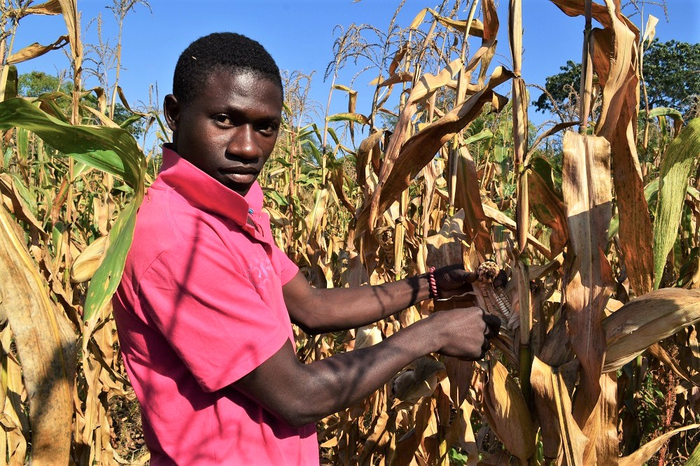A CABI-led study has developed the first forecasting models targeting the larval stages of fall armyworm – using real-time earth observation data and pest occurrence within a farmers field, the models will assist in the fight against the devastating fall armyworm (FAW) pest which in Africa alone is estimated to cause annual yield losses of USD $9.4 billion.

Credit: CABI
A CABI-led study has developed the first forecasting models targeting the larval stages of fall armyworm – using real-time earth observation data and pest occurrence within a farmers field, the models will assist in the fight against the devastating fall armyworm (FAW) pest which in Africa alone is estimated to cause annual yield losses of USD $9.4 billion.
New research conducted by an international team, led by researcher Alyssa Lowry, has demonstrated how the models developed for FAW larval populations in Africa can help smallholder farmers more accurately predict the best time for making a management intervention on their crops to prevent damage. The pest (Spodoptera frugiperda) favours maize but can also have an impact on over 100 other plant species.
The study, published in the journal Crop Protection and with support from colleagues from the Kenya Agricultural and Livestock Research Organisation (KALRO) and the Zambia Agriculture Research Institute (ZARI), built two larval population emergence models based upon field FAW data from maize in Zambia. The models were then validated using similar data from multiple maize sites in Kenya.
Effective control of FAW should be enacted at an early stage in the cropping cycle when larvae can be difficult to detect. The window of time over which early-stage larvae could be controlled is quite broad, and the models help to define the window when an intervention could be made if the pest is present, or when monitoring and scouting activities would be optimal.
The novel modelling of early and later instar larval population emergence and development – in relation to physiological time from planting – now allows alerts to be sent to farmers in advance of an intervention/scouting time, allowing farmers to take preventative action as part of their Integrated Pest Management plans.
Ms Lowry and her colleagues highlight how this modelling has already paid dividends as part of the CABI-led Pest Risk Information Service (PRISE) which provides real-time alerts – via SMS messaging – to farmers advising them when to act to protect their crops from pests.
At the end of the 2019/2020 short rains season in Kenya, for example, a separate survey revealed that 59% of farmers – that received the forecasting service – changed their practices for dealing with FAW.
The interventions of PRISE – based on the earth observation data modelling highlighted by the CABI research – further resulted in a reduced population of FAW and an increase in maize harvest. Indeed, 87% of maize farmers surveyed in separate research believed the time recommended to take action by PRISE was correct.
Analysis on recent PRISE impact data shows a return on investment of 1:182 This means that the 1.8 million farmers reached by PRISE – in the five years since the project launched in 2017– earned an extra £1.5billion in produce value.
Dr Sean T Murphy, one of the main architects of the PRISE project and modelling team lead said, “It is imperative to develop effective pest management strategies and tools for FAW, such as the simple implementable models presented in this study. Although developed for the PRISE initiative, the FAW models could be used in the other pest forecasting systems that have access to continuous real-time temperature datasets and the capacity to process these.”
Ms Lowry adds, “The models do not require farmers to directly estimate action thresholds and can be easily improved upon in the future when data on action thresholds become available for Africa. As the output of these models is a time for action, they can be used in conjunction with a variety of control methods such as biopesticides or for the timing of release of local or exotic instar-specific larval parasitoids.
“The type of modelling used in this study can easily be applied to other major insect pests of farmer crops in Africa and work is already well progressed on several other species within the PRISE project. The team hopes that the models can contribute to a ‘positive stepwise change’ to Africa’s national plant health system.”
Emmanuel Bakirdjian, Africa Regional Director, Precision Development (PxD), a partner in the research, said, “Since pest infestation is easily visible to farmers in Kenya, they have a strong interest in receiving actionable information about pest management. Farmers on the MoA-INFO service often end up applying pesticides too early, which results in a larger infestation later, or too late, which means that the pests are more resilient and have caused more damage.
“Through our partnership with CABI, the information from PRISE has helped nearly 100,000 farmers on the PxD-run MoA-INFO service to learn when pesticides are most likely to be effective. This has helped farmers to recover more crops that have been infested by pests and to avoid over-application of pesticides, which reduces risks to human health and the harms to other important organisms in the local ecosystem.”
Journal
Crop Protection
DOI
10.1016/j.cropro.2022.105966
Method of Research
Experimental study
Subject of Research
Not applicable
Article Title
Optimizing the timing of management interventions against fall armyworm in African smallholder maize: modelling the pattern of larval population emergence and development
Article Publication Date
25-Mar-2022




